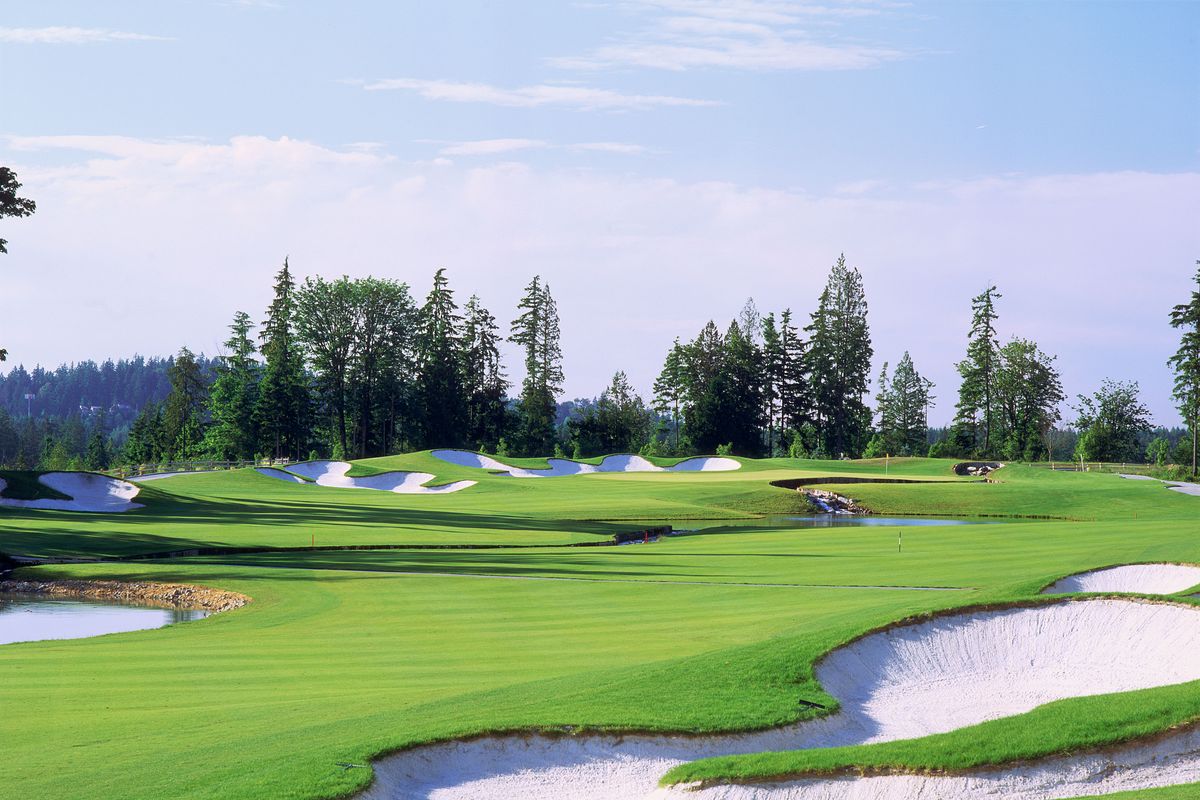Golf: Difficult Washington National gives nothing away

Maybe a C or C-minus.
No, not the golf course’s grade. My grade.
Washington National in Auburn is home to the UW men’s and women’s golf teams. Following an academic theme, the scorecard is also referred to as a report card. A sign that reads “Final Exam” directs players to the 18th tee box.
When all the digits were added up, I had nearly doubled my handicap index. Guess that’s probably closer to a D. Again, not the course’s fault.
Washington National is tough but fair, whether you play the Husky tees at 7,304 yards (permission required) or the Freshman tees at 5,117 yards (recommended for handicaps 25 and up). Our threesome settled on the Senior tees at 6,772 yards (recommended for 0-6 handicaps).
David Putney is in his first year as head pro, but he played the course when it opened in 2000.
“I thought it was a great, championship level course,” Putney said. “It has the length and the bunkers. People think it’s a fun layout, challenging, yet rewarding for good shots.”
Two of the four par 5s are over 600 yards. It’s possible to reach the two in the 530-yard range. It also can be punishing, particularly on No. 17, where two separate water features and a canal hugging the right side of the green await off-target shots.
The front side has a nice mix of par 4s. Three range from 406 to 432 yards, another measured 346 and there’s also the drivable 299-yard seventh. A water hazard runs within 40 yards of the green, followed by a sizable bunker. There’s a safer route to the left, but an uphill second shot is no picnic to a green that narrows from that angle.
No. 5 is the first par 3 and it checks in at 161 yards from the Senior tees, 185 from the Husky tees. Those distances are important to arrive on the proper tier and, if possible, stay below the cup. If you divide the green into quarters, the front-left section sits well below the other three. One member of our group hit the green, but was on the upper tier 35 feet away from the left-front pin location. He three-putted after his first putt failed to take into account nearly 10 feet of break.
The back nine is loaded with quality holes. The 10th, a 412-yard par 4, features a waste bunker that swallows up tee shots to the left and ones that travel longer than 260 yards. Players deal with bunkers on virtually every shot on every hole.
“John Fought does like his bunkers,” said Putney, referring to the course architect.
The closing stretch is terrific, beginning with the 606-yard par-5 14th. Sand and length are the primary issues before encountering a narrow green that extends 35-40 yards from front to back. In addition to Washington National’s abundant sand, there are numerous 40-yard greens.
First-time visitors aren’t sure what to expect on No. 15. It’s just 326 yards, but all you see is some fairway, a big trap in the landing area and a neatly manicured hillside in the distance. With hopes for a magical score long gone, we hit drivers and were all safe. We were also surprised when we walked over the crest of the fairway to see the green nearly surrounded by a water channel that comes into play on 300-yard drives. Fittingly, our group recorded a birdie, a par and a bogey.
“The green isn’t very deep and you’re hitting wedges from a downhill lie,” Putney said. “I’m still trying to figure out the best way to play it.”
The 178-yard, par-3 16th has a large, two-tiered green. A couple of the par 4s are tougher, but our group nominated No. 17 – a 529-yard par 5 with water sand and elevation changes – as the best hole. Putney noted that a photo of the 17th is on the front of the score, err, report card.
The 18th is 425 yards to a wavy green and the usual assortment of traps along the way – a worthy final exam.